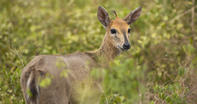
Name
Duiker (sylvicapra grimmia)Description
The name ‘duiker’ comes from the Afrikaans word meaning ‘to dive’, describing this antelope’s manner of ducking and dodging into the bushes when alarmed. The duiker can solely feed on leaves and water, but is also one of few antelope known to eat carrion and insects.Appearance
The common duiker, also known as the grey duiker, is a small and shy antelope. This species’ females are larger than its males which stand 500mm at the shoulders and weighing 15 to 21 kg. Females measure 20mm higher with a mass of 17 to 25 kg. Only the males carry short horns measuring about 10 cm in length.
The duiker is a greyish-beige varying to a reddish-yellow on its upper parts, its under parts largely being white. Most duikers have a black band running down the middle of their face, near the nostrils. There is a significant variation in colour with duiker populations in some areas of South Africa.
Common Duiker Diet
The duiker browses an assortment of bushes, trees and forbs of broad leaves, as well as roots, bark, flowers, seeds, fruits, caterpillars, fungi and nestling birds. In dry and arid areas, the duiker eats wild melons for the water it holds. They are sometimes considered a problem to plantations, vineyards, crops and orchards.Common Duiker Breeding
After a gestation period of about 6 months, the females gives birth to one young weighing about 175 g, and very seldomly gives birth to twins. Before giving birth, the female will hide in dense vegetation.
The young are well developed at birth and can run within their first 24 hours, yet the mother hides them at first. Females give birth once a year, and first mate at the age of 8 - 9 months, only being fully grown at 7 months.
Having no specific breeding period, duikers give birth at any time of year with a possible peak during the summer months. According to habitat and locality, their mating systems vary from monogamous pairs to males with more than one female.
Common Duiker Behaviour
Duikers are mostly active in the late afternoon and at night time, as well as during the early morning hours. They are solitary animals, or females are accompanied by their lambs, and are seldom found in a male-female pair.
Both females and males are territorial, producing scent-marks through the preorbital glands and glands between their front hooves.
They share areas of land only for the purpose of mating, and chase away others of the same sex. Duikers are likely to be the most successful bovid species in Africa with a lifespan of 8 - 11 years.
Common Duiker Habitat
The common duiker is widely distributed across Southern Africa and sub-Saharan Africa, apart from the rainforests of Central Africa.
They are not found in desert regions and avoid open grasslands without shelter. When threatened, they take cover to hide from the predator and will occasionally hide in forests.
Common Duiker Spoor Description
The common, or grey, duiker has a larger spoor than other duiker species, some being pointed and others rounded. One or two unusual variations in spoor size and shape may occur.Predators
Predators to the duiker are all the medium to large predators, mainly including the eagle, leopard, python, jackal, and sometimes the crocodile. They avoid their predators by lying motionlessly and quietly, dashing away at the last moment if the threat has come too close.
The duiker runs with a characteristic diving, zig-zag movement. They use their horns and sharp black hooves to defend themselves, calling alarm with a nasal snort.
When duikers are caught by a predator, they bleat loudly to attract the attention of other duikers and alerts mothers to protect their lambs. Although lambs can run within their first 24 hours, the mother keeps them in hiding and returns to clean and suckle them.
 Learning about the mammals of South Africa is now so much easier for all South Africans - SouthAfrica.co.za is an excellent source of inform...
Learning about the mammals of South Africa is now so much easier for all South Africans - SouthAfrica.co.za is an excellent source of inform...